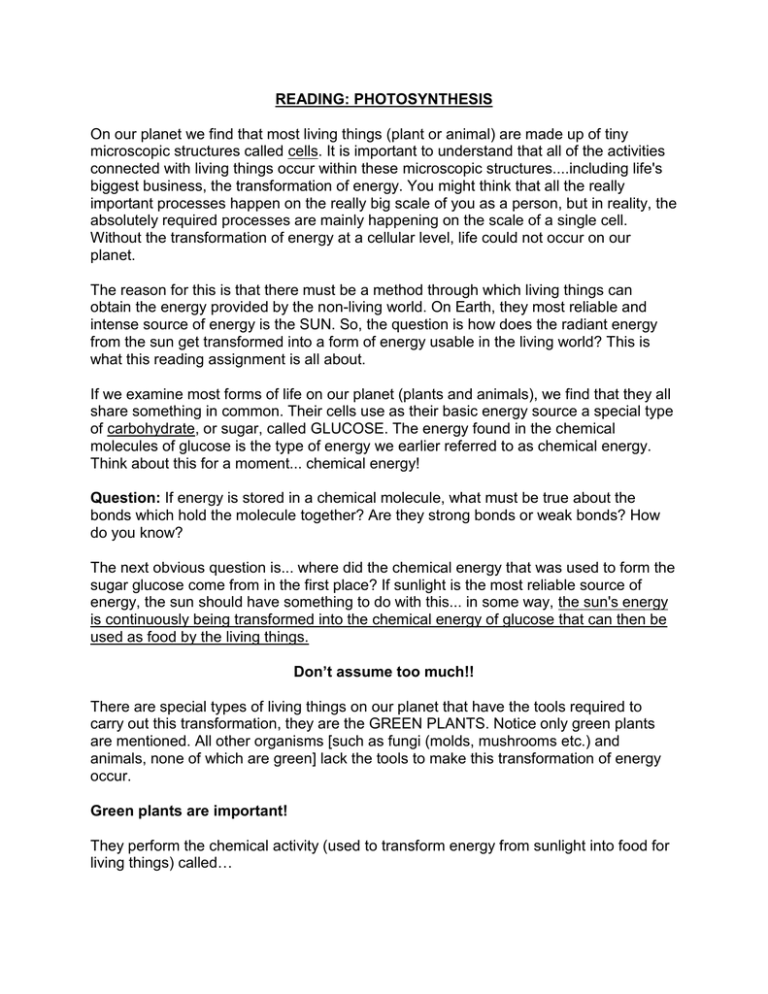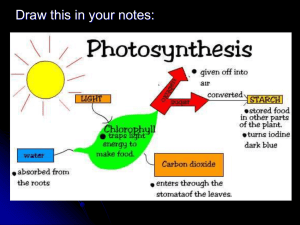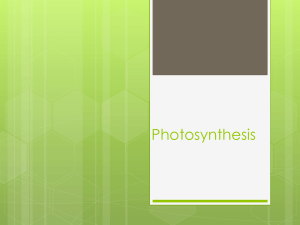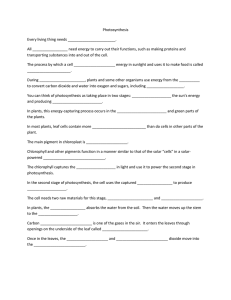Photo-Resp
advertisement

READING: PHOTOSYNTHESIS On our planet we find that most living things (plant or animal) are made up of tiny microscopic structures called cells. It is important to understand that all of the activities connected with living things occur within these microscopic structures....including life's biggest business, the transformation of energy. You might think that all the really important processes happen on the really big scale of you as a person, but in reality, the absolutely required processes are mainly happening on the scale of a single cell. Without the transformation of energy at a cellular level, life could not occur on our planet. The reason for this is that there must be a method through which living things can obtain the energy provided by the non-living world. On Earth, they most reliable and intense source of energy is the SUN. So, the question is how does the radiant energy from the sun get transformed into a form of energy usable in the living world? This is what this reading assignment is all about. If we examine most forms of life on our planet (plants and animals), we find that they all share something in common. Their cells use as their basic energy source a special type of carbohydrate, or sugar, called GLUCOSE. The energy found in the chemical molecules of glucose is the type of energy we earlier referred to as chemical energy. Think about this for a moment... chemical energy! Question: If energy is stored in a chemical molecule, what must be true about the bonds which hold the molecule together? Are they strong bonds or weak bonds? How do you know? The next obvious question is... where did the chemical energy that was used to form the sugar glucose come from in the first place? If sunlight is the most reliable source of energy, the sun should have something to do with this... in some way, the sun's energy is continuously being transformed into the chemical energy of glucose that can then be used as food by the living things. Don’t assume too much!! There are special types of living things on our planet that have the tools required to carry out this transformation, they are the GREEN PLANTS. Notice only green plants are mentioned. All other organisms [such as fungi (molds, mushrooms etc.) and animals, none of which are green] lack the tools to make this transformation of energy occur. Green plants are important! They perform the chemical activity (used to transform energy from sunlight into food for living things) called… PHOTOSYNTHESIS. PHOTOSYNTHESIS Photosynthesis is a chemical activity that can be understood at many levels… from simple explanations to very, very complex descriptions of the process. ISP takes the simplified approach. It is easy to assume that plants absorb sunlight and use its energy to grow directly, after all sunlight is energy. However, if this were the case, why can’t all living cells do this trick? Green plants use specialized cells, and the process of photosynthesis, to capture the energy from sunlight and store it by creating sugar (glucose) molecules. It is important for you to realize that this alone can not sustain life. Plants, much less all the animals, can not stay alive if this was all that happened. Remember, glucose is like a storage house for energy, storing the chemical energy obtained from the sun. A second important activity must occur to release this stored energy. This second reaction is called… RESPIRATION How Does Photosynthesis Work? In a way, the word PHOTOSYNTHESIS defines itself: Photo = light, or radiant ENERGY which provides the ENERGY to... Synthesis = to build or construct But what is constructed by the green plants? They use “simple” chemicals, meaning that they have a small number of atoms in each molecule, to construct more “complex” chemicals such as the sugar called glucose. The simpler chemicals include carbon dioxide and water which must be available to the green plant. So, using the energy from sunlight, carbon dioxide and water molecules chemically react, meaning that their atoms are rearranged into the form called glucose. During this rearrangement, the sun's radiant energy is transformed into chemical energy which is stored in the glucose molecule. Here is a simple word equation which summarizes the whole thing: Carbon Dioxide + Water −−−> Glucose + Oxygen + Water Question: How does sunlight fit into this equation? Where should it be written in? To make all this happen a special substance is required. That substance is called... CHLOROPHYLL — it is the green pigment found in green plants. Chlorophyll is what makes green plants green. Chlorophyll has the ability to trap the sun's radiant energy, and use it to rearrange those carbon dioxide and water molecules into the glucose. Only chlorophyll can do this. No chlorophyll would mean no photosynthesis. Let's summarize our story of photosynthesis: Carbon Dioxide + Water + Sunlight == Glucose + Oxygen + Water captured by stored chemical given off as chlorophyll energy waste products. RESPIRATION Some form of respiration occurs in EVERY living thing, every cell of every plant AND animal. Respiration releases the chemical energy stored in food. Respiration releases the chemical energy stored in glucose, which is used by the cells to carry out their life activities (growing, moving, etc.). The following diagram attempts to summarize the important relationship between photosynthesis and respiration. (This reading is concerned with photosynthesis. Your next reading focuses on respiration.) Sunlight (radiant energy) is Transformed through the process of Photosynthesis in Green Plants Transforming the radiant energy into GLUCOSE (chemical energy) which can be Respired by Plants & Animals to Transform chemical energy Into other forms Required to continue living. RESPIRATION - The chemical activity occurring in all plant and animal cells releasing the energy from glucose. Respiration is NOT the same as what we call breathing! Respiration is a chemical reaction… Photosynthesis Review 1-In the process of photosynthesis ______________ energy is transformed into ________ energy. 2-The reactants of photosynthesis are _____________, _____________ and _________. 3-The products of photosynthesis are __________, ___________, and _____________. 4-One of the waste products of photosynthesis is ______________. The plant does not need it so it _____________________________________________________________. 5-Photosynthesis happens in the _________________. The chemical in the chloroplast is called ________________________. 6- The prefix chloro- means ___________________. 7-The prefix photo- means ___________________. 8-The suffix –synthesis means ___________________. 9-After Oxygen is made it is stored in the ________________ layer and finally released through the __________________. 10-The __________________ opens at night to release gas and water. 11-The part of the leaf that is NOT a cell, that is made of wax is the ________________. 12-The vein transports materials in the leaf. The phloem transports _______________ and the xylem transports ____________________. 13-Three kinds of carbohydrates are ____________________, ______________ and ___________________.







